Development and Tests of the Solar Air Heater with Thermal Energy Storage
Abstract
:1. Introduction
- The direct gain system, in which south-facing glass admits solar energy into the house, where it strikes masonry floors and walls that absorb and store the solar heat and radiate it back out into the room at night.
- The thermal storage wall (Trombe wall), in which the heat is stored in a wall which also absorbs the solar energy when it comes through the glazing.
- The solar greenhouse, in which the features of the solar thermal storage wall and the direct gain approach can be combined.
- The roof pond, in which a shallow pond or tank of water sits on a flat roof with its surface generally contained by a transparent plastic sheet.
- The use of solar energy can effectively preheat ventilation air in the building, which increases the efficiency of heat recovery in the air-handling unit and reduces the primary energy consumption;
- The SAH can be easily integrated both into new and existing buildings (including traditional, energy-efficient, and net-zero energy objects);
- The SAH allows for heat accumulation during the day and uses it at night;
- Due to the reduction of primary energy consumption, the use of SAH can be considered an environmentally friendly solution to improve the energy performance of buildings.
- The amount of heat stored in the SAH is limited and insufficient to preheat ventilation air throughout the night;
- The availability of solar radiation is the lowest during winter, which is when the most heat is consumed by buildings (relatively low coherence between the demand for heat and the availability of solar radiation);
- Implementation of the SAH increases the airflow resistance, which increases the electricity consumption by fans in the air-handling unit;
- The SAH configured in the form of the solar chimney has a limited surface, and solar irradiation reaching each wall depends on the orientation (significantly less solar energy reaches the north wall than the south wall).
2. Materials and Methods
2.1. Experimental Rig and Procedure
- Solar air heater made of a special type of concrete (“akubet”) composed of ceramic aggregate with iron and manganese oxides on the aluminum cement bond. Good thermal parameters of “akubet” result from the fact that it was originally developed to use in wood-fired stoves [41,42]. The main geometrical and material parameters of the developed SAH are shown in Figure 2 and Table 3, respectively. A unit with a length of 1008 mm was tested, but in practical applications it can be extended by adding further cubic ceramic components.
- An artificial heat source composed of 16 halogen lamps with individual electric power of 150 W (2400 W in total);
- An air fan with a nominal flow of 840 m3/h;
- A set of K-type (NiCR-Ni) thermocouple sensors to measure air temperature at the inlet and the outlet from the SAH (with a measuring range from −40 °C to 1200 °C and accuracy ±2.5 °C or ±0.0075 × [t]);
- A set of resistance temperature sensors to measure the temperature of the internal and external walls of the SAH (with a measuring range from −50 °C to 400 °C and tolerance ±0.3 + 0.005 × [t]);
- Thermoanemometer to measure airflow (with measuring range 0–20 m/s and tolerance ±0.02 m/s + 3%);
- WAGO PFC200 PLC controller with a set of input and output modules;
- The PC with CoDeSys software;
- The infrared camera NEC ThermoTracer H2640 with a thermal resolution of 640 × 480 pixels, measuring range from 0 to 120 °C, and accuracy ±2% (of reading) or ±2 °C.
- The relationship between the form of the SAH and the increase in the temperature of the ventilation air (point Section 3.1);
- The relationship between the temperature of the internal walls of the solar air heater and the increase in the temperature of the ventilation air (point Section 3.2);
- The relationship between the form of the SAH and the power transferred from the SAH to the ventilation air (point Section 3.3);
- The relationship between the flow of the ventilation air and power transferred from the SAH to the ventilation air (point Section 3.4).
- SAH in the form of the solar chimney was heated by an artificial heat source from all sides (see Figure 4a);
- SAH in the form of a solar thermal wall was heated by an artificial heat source only from one side and other walls were insulated from the heat source (see Figure 4b). Opposite to the classic Trombe walls, glazing was not applied at the current stage, but it can be implemented in the future.
2.2. Numerical Analysis
- Building located in Krakow, Poland;
- Building designed in passive technology;
- The heat pump is used as a heat source (in central heating system and for heating domestic hot water);
- Mechanical ventilation with recuperator is used as a ventilation system (assumed recuperator’s efficiency: 70%);
- Air-handling unit with recuperator located in the attic (all air ducts insulated);
- Supply air inlet connected with the outlet from the solar air heater;
- Heated surface: 158.9 m2;
- Ventilated volume: 362.8 m3;
- Required airflow: 246.5 m3/h.
3. Results and Discussion
3.1. Relationship between the Form of the SAH and the Increase in the Temperature of the Ventilation Air
3.2. Relationship between the Temperature of the Internal Walls of the SAH and the Increase in the Temperature of the Ventilation Air
3.3. Relationship between the Form of the SAH and the Power Transferred from the SAH to the Ventilation Air
3.4. Relationship between the Flow and the Increase in the Temperature of the Ventilation Air
3.5. Relationship between the Flow of the Ventilation Air and Power Transferred from the SAH to the Ventilation Air
3.6. Estimation of the Efficiency of the Proposed SAH and its Impact on the Building Performance
- Case A: the SAH operates as a solar chimney;
- Case B: the SAH operates as a solar thermal wall (see Figure 11);
4. Conclusions
- As was shown, by using solar radiation (simulated by an artificial light source), it is possible to heat the ceramic material and use the accumulated heat to preheat the ventilation air for the subsequent hours.
- The power transferred from the solar air heater to the ventilation air was mainly a result of the difference between the temperature of the ventilation air at the inlet and outlet from the unit, the temperature of the internal surface of the unit, and airflow. When airflow was set to 150 m3/h, the maximum power observed under stable working conditions was approx. 355.0 W (when the developed solar air heater operated as a solar chimney), and approx. 165.0 W (when it operated as a solar thermal wall).
- A higher power, approx. 385 W, was observed when the developed solar air heater operated as a solar chimney and the airflow was 200 m3/h.
- Experimental results have been used to calculate the efficiency of the solar air heater in real conditions and assess the impact of the solar air heater on the energy performance of the exemplary residential building. The total efficiency in the case of the solar chimney was estimated as 0.25, while in the case of the thermal wall it was estimated as 0.78, which resulted in the annual reduction in the final energy usage at a level of 190.7 kWh and 556.1 kWh, respectively (4.8 and 14.0%).
- In practice, the total efficiency of the proposed solutions can be significantly higher due to the possibility of increasing the length and shape of the solar air heater.
Author Contributions
Funding
Acknowledgments
Conflicts of Interest
References
- Santamouris, M.; Vasilakopoulou, K. Present and future energy consumption of buildings: Challenges and opportunities towards decarbonisation. E-Prime-Adv. Electr. Eng. Electron. Energy 2021, 1, 100002. [Google Scholar] [CrossRef]
- Krawczyk, D.A. Analysis of Energy Consumption for Heating in a Residential House in Poland. Energy Procedia 2016, 95, 216–222. [Google Scholar] [CrossRef]
- Shayan, M.E. Solar Energy and Its Purpose in Net-Zero Energy Building. In Zero-Energy Buildings—New Approaches and Technologies; IntechOpen: London, UK, 2020. [Google Scholar] [CrossRef]
- Żołądek, M.; Filipowicz, M.; Sornek, K.; Figaj, R. Energy performance of the photovoltaic system in urban area-case study. IOP Conf. Ser. Earth Environ. Sci. 2019, 214, 012123. [Google Scholar] [CrossRef]
- Papis-Frączek, K.; Sornek, K. A Review on Heat Extraction Devices for CPVT Systems with Active Liquid Cooling. Energies 2022, 15, 6123. [Google Scholar] [CrossRef]
- Goel, V.; Hans, V.S.; Singh, S.; Kumar, R.; Pathak, S.K.; Singla, M.; Bhattacharyya, S.; Almatrafif, E.; Gill, R.S.; Saini, R.P. A comprehensive study on the progressive development and applications of solar air heaters. Solar Energy 2021, 229, 112–147. [Google Scholar] [CrossRef]
- Pachori, H.; Choudhary, T.; Sheorey, T. Significance of thermal energy storage material in solar air heaters. Mater. Today Proc. 2022, 56, 126–134. [Google Scholar] [CrossRef]
- Sharma, A.; Tyagi, V.V.; Chen, C.R.; Buddhi, D. Review on thermal energy storage with phase change materials and applications. Renew. Sustain. Energy Rev. 2009, 13, 318–345. [Google Scholar] [CrossRef]
- Labus, M.; Labus, K. Thermal conductivity and diffusivity of fine-grained sedimentary rocks. J. Therm. Anal. Calorim. 2018, 132, 1669–1676. [Google Scholar] [CrossRef]
- Kubiś, M.; Pietrak, K.; Cieślikiewicz, Ł.; Furmański, P.; Wasik, M.; Seredyński, M.; Wiśniewski, T.S.; Łapka, P. On the anisotropy of thermal conductivity in ceramic bricks. J. Build. Eng. 2020, 31, 101418. [Google Scholar] [CrossRef]
- Asadi, I.; Shafigh, P.; bin Abu Hassan, Z.F.; Mahyuddin, N.B. Thermal conductivity of concrete—A review. J. Build. Eng. 2018, 20, 81–93. [Google Scholar] [CrossRef]
- Hillel, D. Thermal properties and processes. Encycl. Soils Environ. 2005, 4, 156–163. [Google Scholar] [CrossRef]
- Soltani, F.; Toghraie, D.; Karimipour, A. Experimental measurements of thermal conductivity of engine oil-based hybrid and mono nanofluids with tungsten oxide (WO3) and MWCNTs inclusions. Powder Technol. 2020, 371, 37–44. [Google Scholar] [CrossRef]
- Abdin, Z.; Khalilpour, K.R. Single and Polystorage Technologies for Renewable-Based Hybrid Energy Systems. In Polygeneration with Polystorage: For Chemical and Energy Hubs; Academic Press: Cambridge, MA, USA, 2019; pp. 77–131. [Google Scholar] [CrossRef]
- Szokolay, S. Passive heating and cooling. In Sun Power (Second Edition): An Introduction to the Applications of Solar Energy; Pergamon Press: Oxford, UK, 1983; Volume 3, pp. 113–131. [Google Scholar] [CrossRef]
- Passive Solar Design—Sustainability. Available online: https://sustainability.williams.edu/green-building-basics/passive-solar-design/ (accessed on 14 August 2022).
- Xiong, Q.; Alshehri, H.M.; Monfaredi, R.; Tayebi, T.; Majdoub, F.; Hajjar, A.; Delpisheh, M.; Izadi, M. Application of phase change material in improving trombe wall efficiency: An up-to-date and comprehensive overview. Energy Build. 2022, 258, 111824. [Google Scholar] [CrossRef]
- Quesada, G.; Rousse, D.; Dutil, Y.; Badache, M.; Hallé, S. A comprehensive review of solar facades. Opaque solar facades. Renew. Sustain. Energy Rev. 2012, 16, 2820–2832. [Google Scholar] [CrossRef]
- Hu, Z.; He, W.; Ji, J.; Zhang, S. A review on the application of Trombe wall system in buildings. Renew. Sustain. Energy Rev. 2017, 70, 976–987. [Google Scholar] [CrossRef]
- Hami, K.; Draoui, B.; Hami, O. The thermal performances of a solar wall. Energy 2012, 39, 11–16. [Google Scholar] [CrossRef]
- Hu, Z.; Zhang, S.; Hou, J.; He, W.; Liu, X.; Yu, C.; Zhu, J. An experimental and numerical analysis of a novel water blind-Trombe wall system. Energy Convers. Manag. 2020, 205, 112380. [Google Scholar] [CrossRef]
- Dabaieh, M.; Serageldin, A.A. Earth air heat exchanger, Trombe wall and green wall for passive heating and cooling in premium passive refugee house in Sweden. Energy Convers. Manag. 2020, 209, 112555. [Google Scholar] [CrossRef]
- Singh, A.P.; Akshayveer; Kumar, A.; Akshayveer; Kumar, A.; Singh, O.P. Designs for high flow natural convection solar air heaters. Solar Energy 2019, 193, 724–737. [Google Scholar] [CrossRef]
- Singh, A.P.; Kumar, A.; Akshayveer; Singh, O.P. Effect of integrating high flow naturally driven dual solar air heaters with Trombe wall. Energy Convers. Manag. 2021, 249, 114861. [Google Scholar] [CrossRef]
- Bevilacqua, P.; Bruno, R.; Szyszka, J.; Cirone, D.; Rollo, A. Summer and winter performance of an innovative concept of Trombe wall for residential buildings. Energy 2022, 258, 124798. [Google Scholar] [CrossRef]
- Mokni, A.; Lashin, A.; Ammar, M.; Mhiri, H. Thermal analysis of a Trombe wall in various climatic conditions: An experimental study. Solar Energy 2022, 243, 247–263. [Google Scholar] [CrossRef]
- Rabani, M. Experimental comparison of energy and exergy analysis of a new designed and a Normal Trombe wall. Energy 2022, 260, 125050. [Google Scholar] [CrossRef]
- Li, W.; Chen, W. Numerical analysis on the thermal performance of a novel PCM-encapsulated porous heat storage Trombe-wall system. Solar Energy 2019, 188, 706–719. [Google Scholar] [CrossRef]
- Duan, S.; Wang, L.; Zhao, Z.; Zhang, C. Experimental study on thermal performance of an integrated PCM Trombe wall. Renew. Energy 2021, 163, 1932–1941. [Google Scholar] [CrossRef]
- Li, J.; Zhang, Y.; Zhu, Z.; Zhu, J.; Luo, J.; Peng, F.; Sun, X. Thermal comfort in a building with Trombe wall integrated with phase change materials in hot summer and cold winter region without air conditioning. Energy Built Environ. 2022, in press. [Google Scholar] [CrossRef]
- Wijesuriya, S.; Tabares-Velasco, P.C.; Biswas, K.; Heim, D. Empirical validation and comparison of PCM modeling algorithms commonly used in building energy and hygrothermal software. Build. Environ. 2020, 173, 106750. [Google Scholar] [CrossRef]
- Javidan, M.; Asgari, M.; Gholinia, M.; Nozari, M.; Asgari, A.; Ganji, D.D. Thermal energy storage inside the chamber with a brick wall using the phase change process of paraffinic materials: A numerical simulation. Theor. Appl. Mech. Lett. 2022, 12, 100329. [Google Scholar] [CrossRef]
- Javidan, M.; Asgari, M.; Gholinia, M.; Nozari, M.; Asgari, A.; Ganji, D.D. Investigation of convection and radiation heat transfer of paraffinic materials and storage of thermal energy in melting process of PCMs in the cavity with transparent inner walls. Energy Rep. 2022, 8, 5522–5532. [Google Scholar] [CrossRef]
- Yang, L.; Dhahad, H.A.; Chen, M.; Huang, Z.; Anqi, A.E.; Rajhi, A.A.; Qader, D.N. Transient analysis of buildings with Trombe wall in a southern envelope and strengthening efficacy by adding phase change material. J. Build. Eng. 2022, 55, 104670. [Google Scholar] [CrossRef]
- Sornek, K.; Filipowicz, M.; Rzepka, K. The development of a thermoelectric power generator dedicated to stove-fireplaces with heat accumulation systems. Energy Convers. Manag. 2016, 125, 185–193. [Google Scholar] [CrossRef]
- Abdeen, A.; Serageldin, A.A.; Ibrahim, M.G.E.; El-Zafarany, A.; Ookawara, S.; Murata, R. Experimental, analytical, and numerical investigation into the feasibility of integrating a passive Trombe wall into a single room. Appl. Therm. Eng. 2019, 154, 751–768. [Google Scholar] [CrossRef]
- Stazi, F.; Mastrucci, A.; Munafò, P. Life cycle assessment approach for the optimization of sustainable building envelopes: An application on solar wall systems. Build. Environ. 2012, 58, 278–288. [Google Scholar] [CrossRef]
- Özdenefe, M.; Atikol, U.; Rezaei, M. Trombe wall size-determination based on economic and thermal comfort viability. Solar Energy 2018, 174, 359–372. [Google Scholar] [CrossRef]
- Rabani, M.; Kalantar, V.; Rabani, M. Heat transfer analysis of a Trombe wall with a projecting channel design. Energy 2017, 134, 943–950. [Google Scholar] [CrossRef]
- Lin, Y.; Ji, J.; Lu, X.; Luo, K.; Zhou, F.; Ma, Y. Thermal and electrical behavior of built-middle photovoltaic integrated Trombe wall: Experimental and numerical study. Energy 2019, 189, 116173. [Google Scholar] [CrossRef]
- Sornek, K.; Filipowicz, M.; Rzepka, K. Study of clean combustion of wood in a stove-fireplace with accumulation. J. Energy Inst. 2017, 90, 613–623. [Google Scholar] [CrossRef]
- Sornek, K. A study of selected aspects of the operation of thermoelectric generator incorporated in a biomass-fired stove. E3S Web Conf. 2016, 10, 00087. [Google Scholar] [CrossRef]
- Polish Methodology of Evaluation of the Energy Performance of Buildings. Available online: https://sip.lex.pl/akty-prawne/dzu-dziennik-ustaw/metodologia-wyznaczania-charakterystyki-energetycznej-budynku-lub-18176491 (accessed on 17 August 2022).
- Pecceu, S.; Caillou, S. Efficiency of heat recovery ventilation in real conditions: Feedback from several measurement campaigns|AIVC. In Proceedings of the 40th AIVC—8th TightVent—6th Venticool Conference, Ghent, Belgium, 15–16 October 2019. [Google Scholar]
- Solar Calendar for Krakow. Available online: https://pl.365.wiki/world/poland/krakow/sun/calendar/ (accessed on 1 September 2022).
- Electricity Price Statistics—Statistics Explained. Available online: https://ec.europa.eu/eurostat/statistics-explained/index.php?title=Electricity_price_statistics (accessed on 19 August 2022).
- Sornek, K.; Goryl, W.; Figaj, R.; Dąbrowska, G.; Brezdeń, J. Development and Tests of the Water Cooling System Dedicated to Photovoltaic Panels. Energies 2022, 15, 5884. [Google Scholar] [CrossRef]
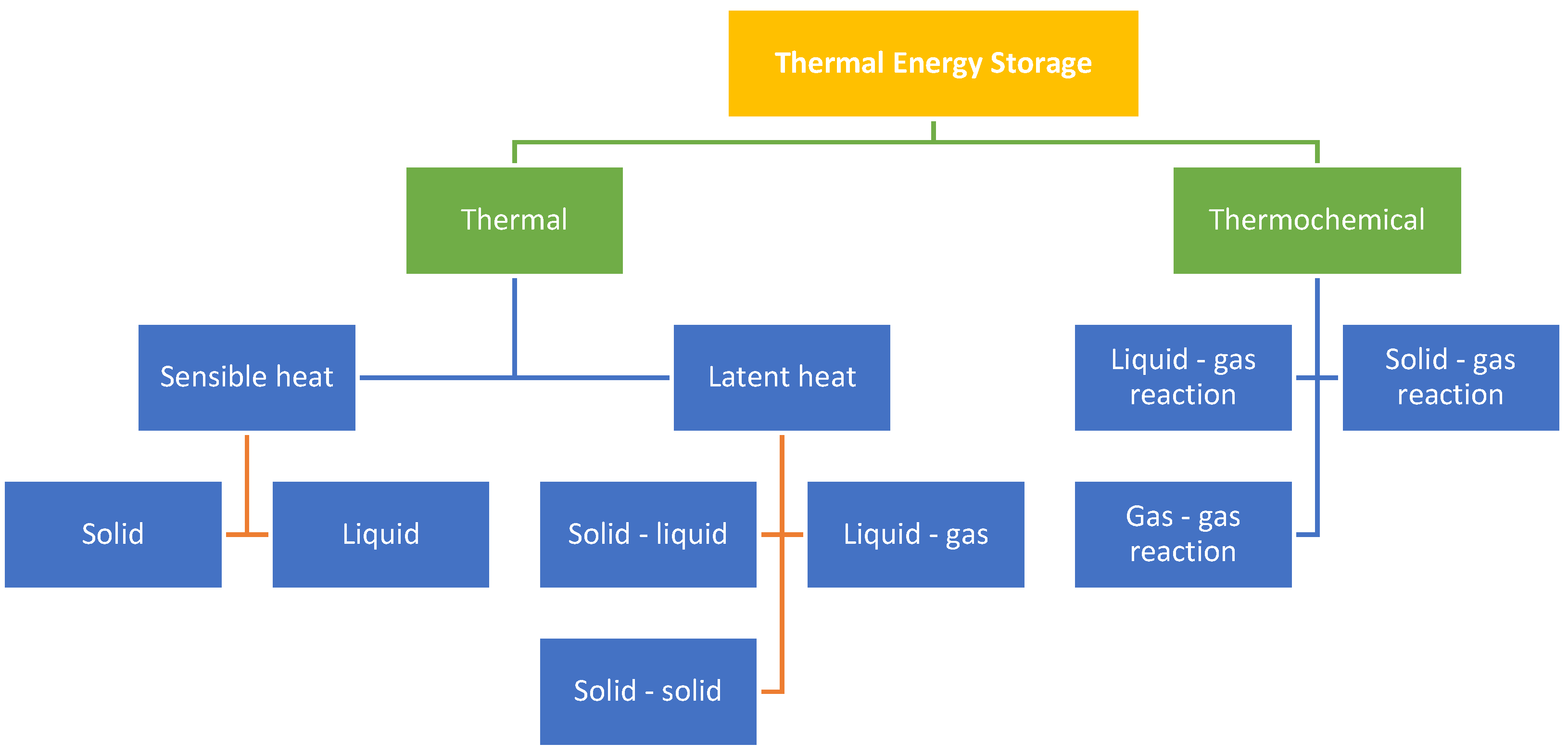
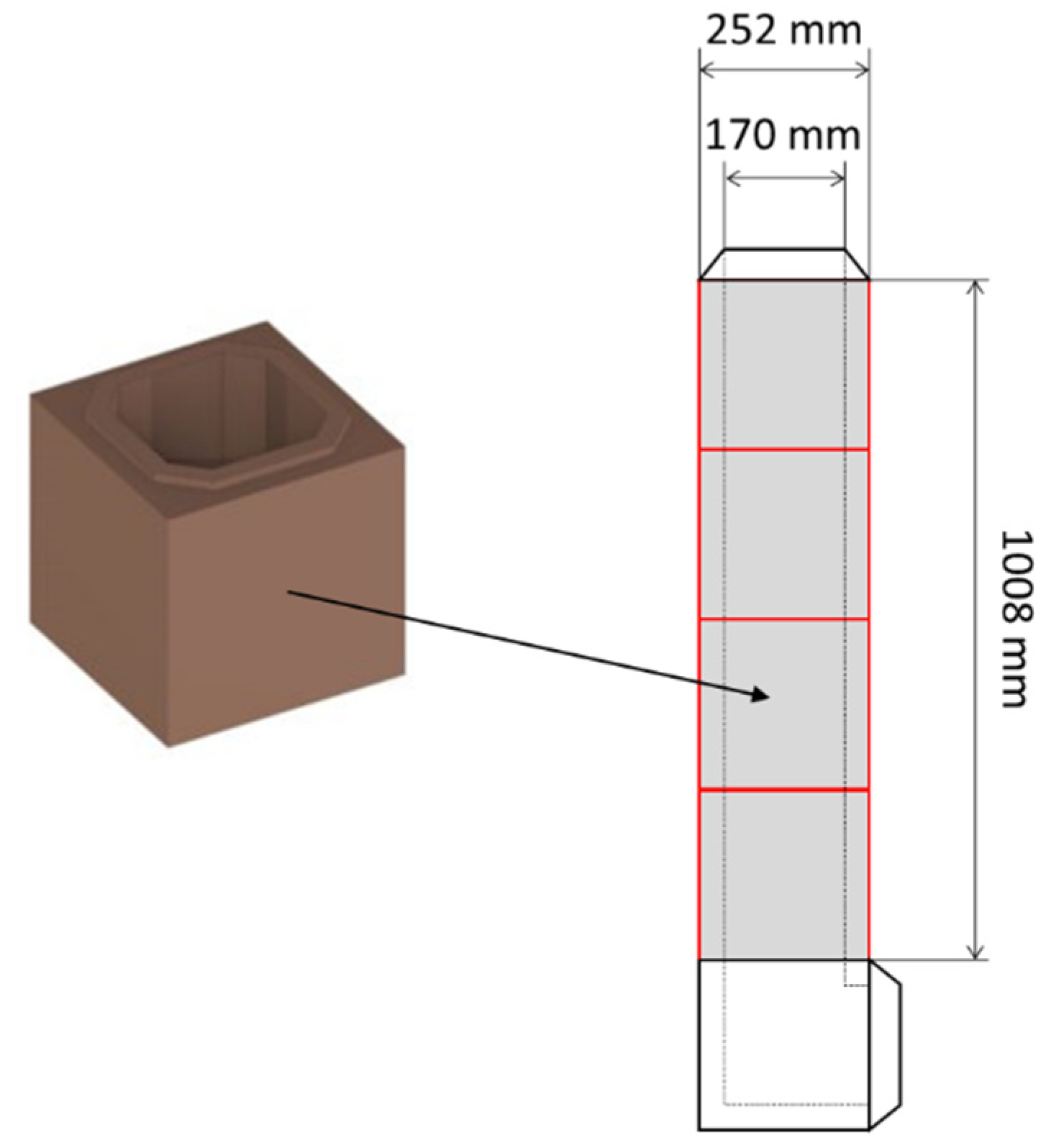
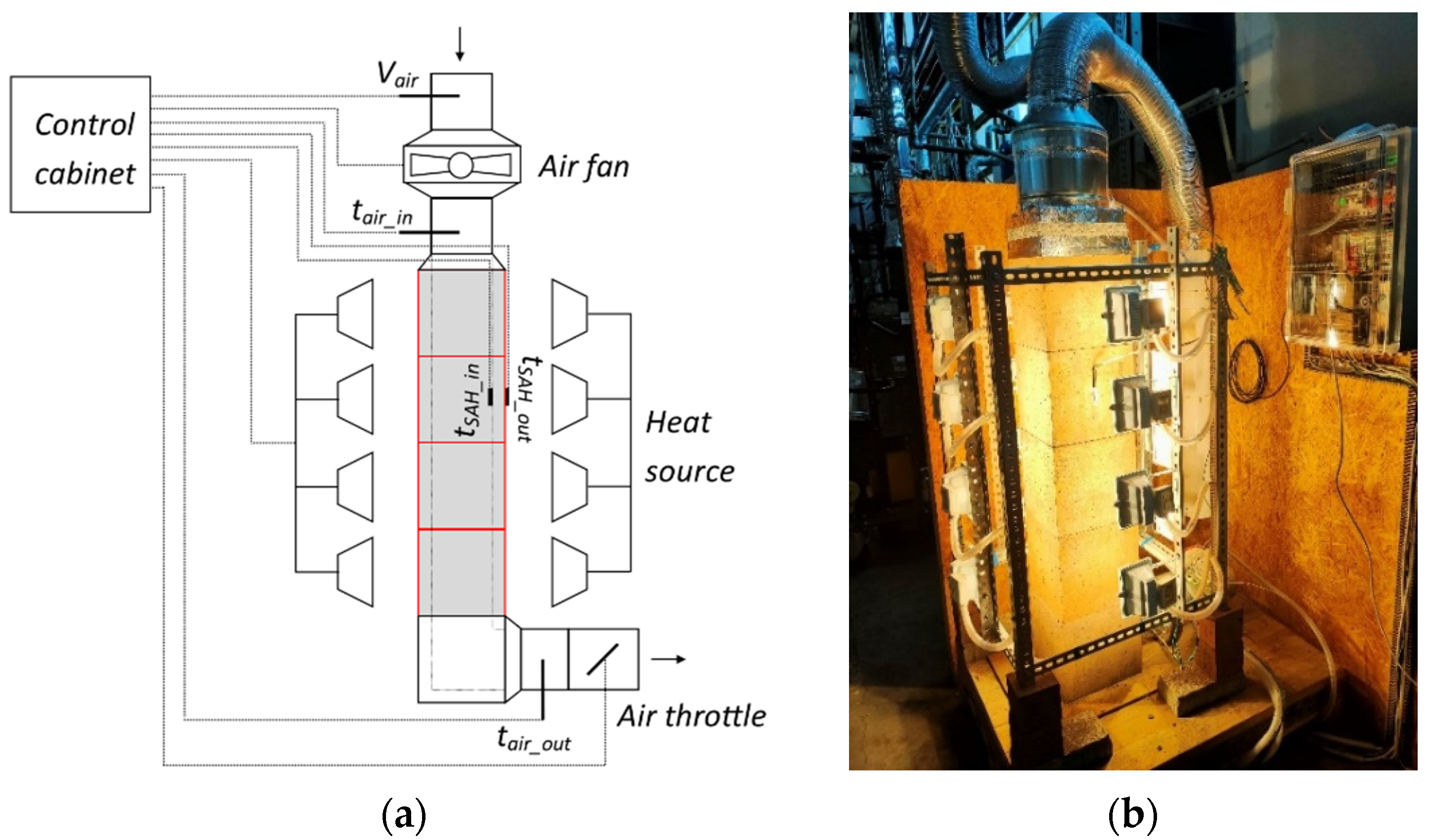
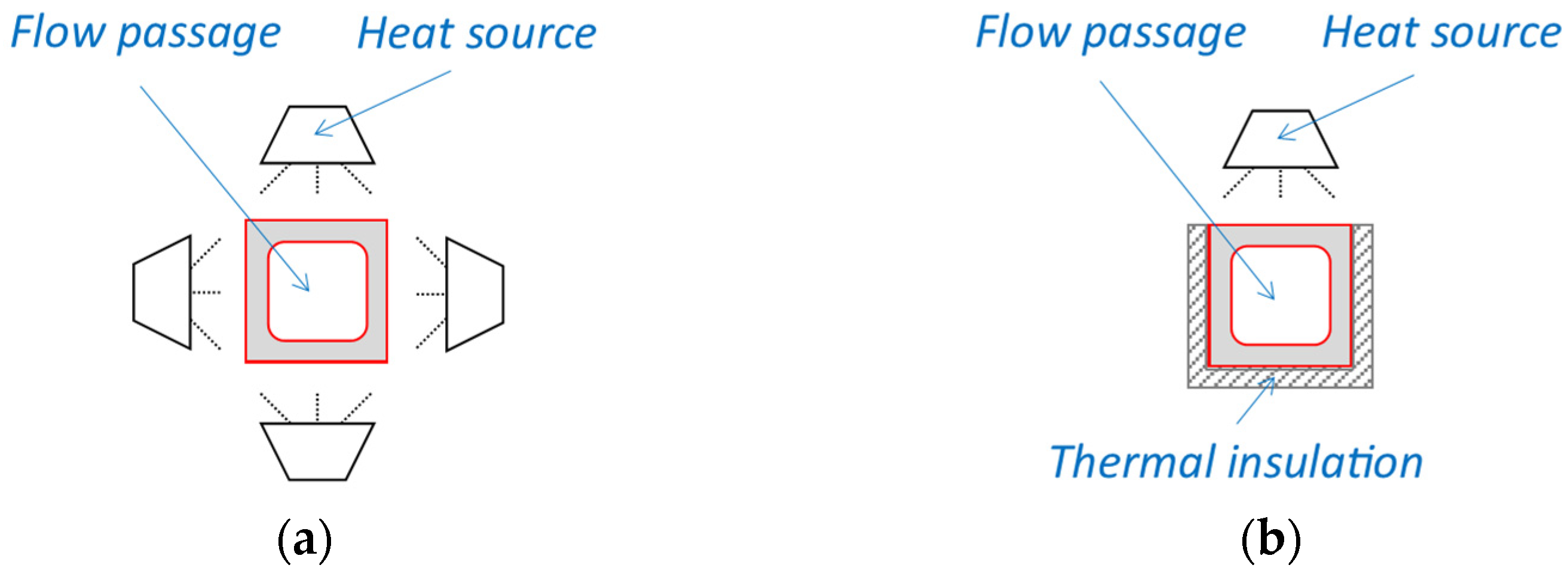


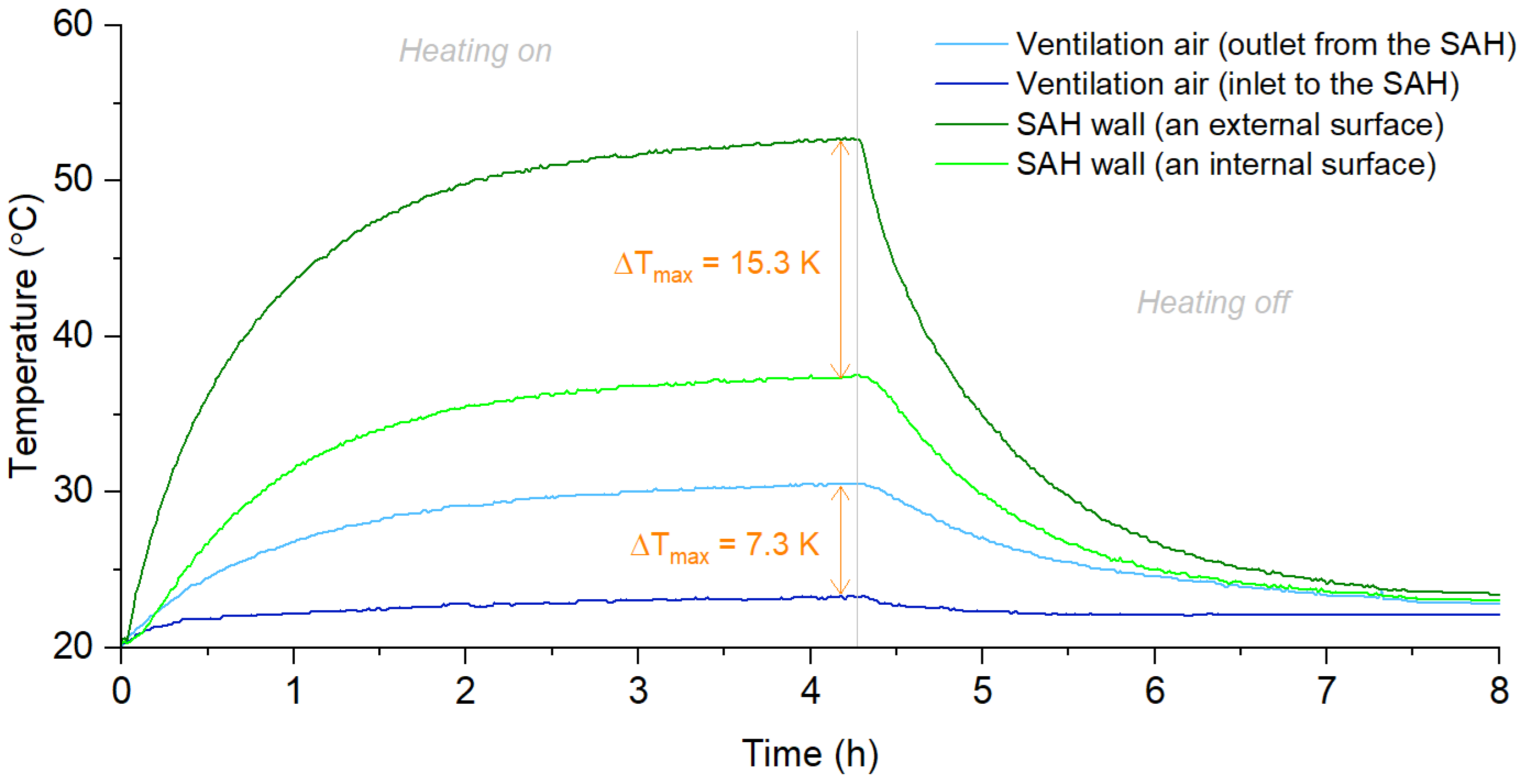
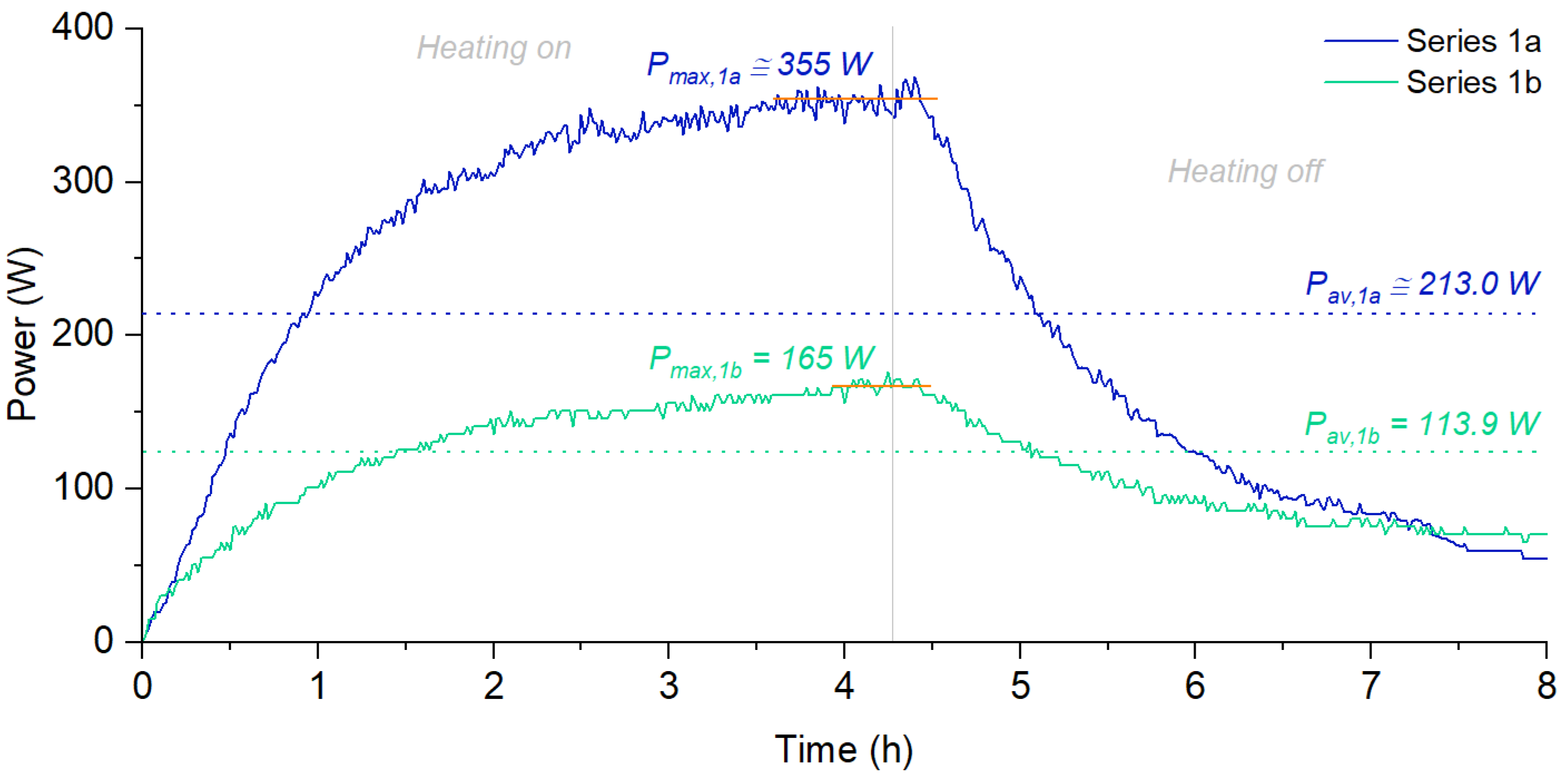
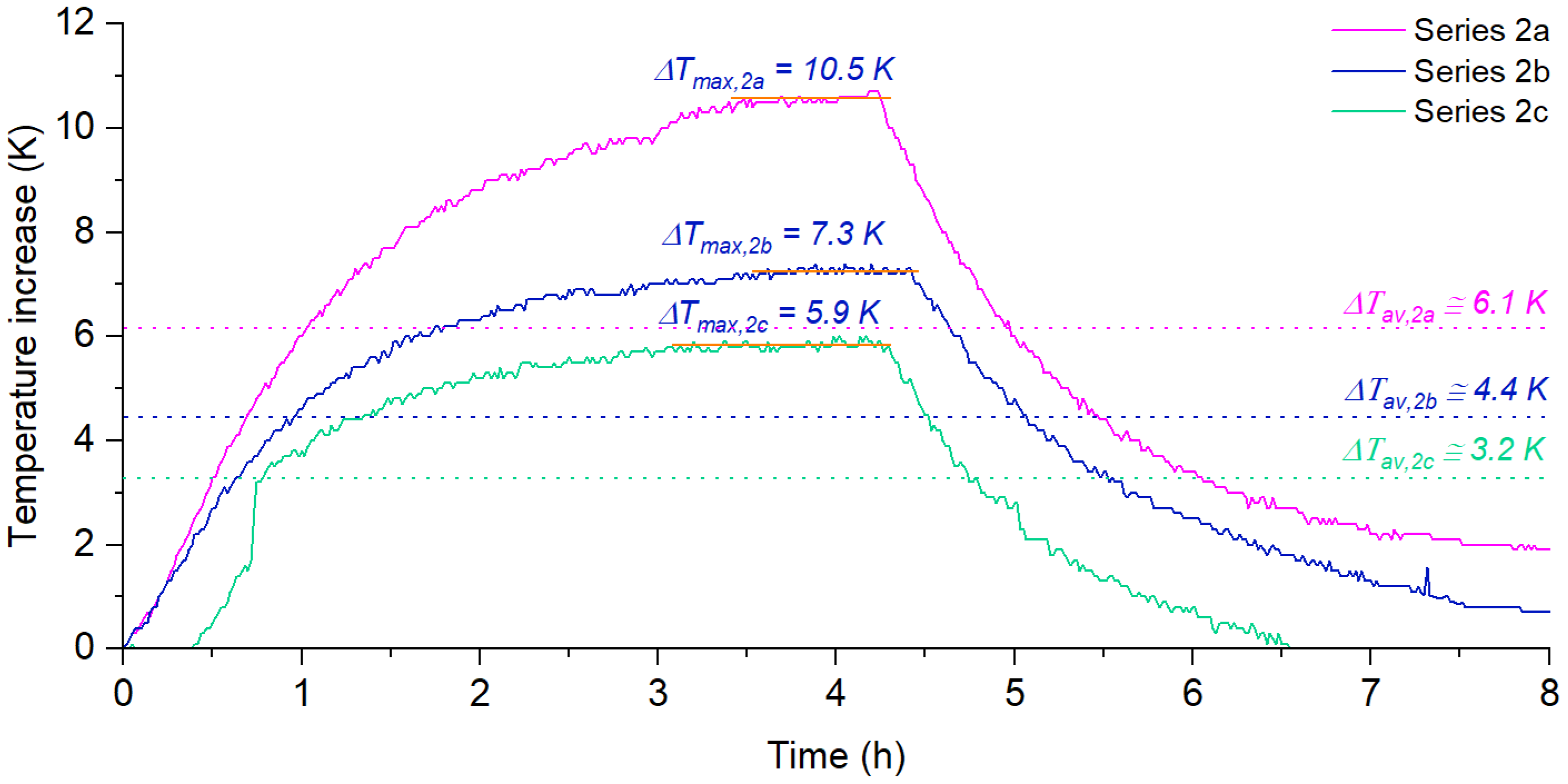


| Material | Temperature Range °C | Thermal Conductivity W/(m K) | Density kg/m3 | Specific Heat J/kg K |
|---|---|---|---|---|
| Rock | 20 | 0.4–7.0 | 2560 | 879 |
| Brick | 20 | 0.6–1.0 | 1600 | 840 |
| Concrete | 20 | 0.6–3.3 | 1900–2300 | 880 |
| Water | 0–100 | 0.57 | 1000 | 4190 |
| Engine oil | Up to 160 | 0.13 | 888 | 1880 |
| Authors | The Form of SAH | Parameters/Objective | Heat Accumulation | Conducted Works | Ref. |
|---|---|---|---|---|---|
| Current work | Solar chimney and solar thermal wall | Development of a novel configuration of SAH that is composed of inexpensive accumulative material and tests the operation parameters of the proposed SAH composed in the form of the solar chimney and solar thermal wall. | Yes | Numerical and experimental studies | - |
| Singh et al. (2021) | Trombe wall | Investigation of a new concept of integrating a high-flow naturally-driven dual heating system of Trombe wall integrated with SAH. | No | Numerical studies | [24] |
| Bevilacqua et al. (2022) | Trombe wall | Introduction of an innovative configuration of a modular Trombe wall that can be easily integrated into existing buildings | No | Numerical studies | [25] |
| Mokni et al. (2022) | Trombe wall | Evaluation of the different heat exchange coefficients, the thermo-circulation in the gap, and the total amount of heat captured during the sunshine hours. | No | Numerical and experimental studies | [26] |
| Abdeed et al. (2019) | Trombe wall | Optimum design of Trombe wall, enhancing the thermal comfort. | No | Numerical studies | [36] |
| Stazi et al. (2012) | Trombe wall | The optimization of energy and environmental performances of complex building envelopes. | No | Numerical studies | [37] |
| Özdenefe et al. (2018) | Trombe wall | Developing an approach for revealing the conditions and features of economically feasible Trombe walls by taking both annual energy consumption and thermal comfort into consideration. | No | Numerical studies | [38] |
| Rabani et al. (2017) | Trombe wall with projecting channel design | Assessment of the temperature variation of the Trombe wall back and absorber over a 24 h basis for winters and summers. | No | Numerical studies | [39] |
| Javidan et al. (2022) | N/A | Study the melting process of PCM by applying constant heat flux and temperature. | Yes | Numerical studies | [32] |
| Duan et al. (2020) | Trombe wall with PCM | Thermal performance improvement of Trombe wall via PCM encapsulated as a thermal storage. | Yes | Experimental studies | [29] |
| Yang et al. (2022) | Trombe wall with PCM | The contrast of energy analysis of a typical building and a building equipped with a Trombe wall. | Yes | Numerical and experimental studies | [34] |
| Li and Chen (2019) | Trombe wall with PCM | Assessment and discussion of a new design of a solar composite wall with the porous heat storage layer. | Yes | Numerical studies | [28] |
| Lin et al. (2019) | Trombe wall with photovoltaic (PV) panel | Investigation of a PV panel integrated with Trombe wall for dual purposes (electricity generation and space heating) and comparison with the classic Trombe wall. | No | Numerical and experimental studies | [40] |
| Temperature Range °C | Thermal Conductivity W/(m K) | Density kg/m3 | Specific Heat J/(kg K) |
|---|---|---|---|
| Up to 350 | 1.81 | 2750 | 640 |
| Parameter | Series 1a | Series 1b |
|---|---|---|
| The maximum increase in the temperature observed during the experiment, K | 7.3 | 3.3 |
| The average increase in the temperature (during the whole process), K | 4.4 | 2.3 |
| The average increase in the temperature in the first phase (when the light was on), K | 5.5 | 2.5 |
| The average increase in the temperature in the second phase (when the light was off), K | 3.2 | 2.1 |
| Parameter | Ventilation Air | SAH Surface | ||
|---|---|---|---|---|
| Inlet to the SAH | An outlet from the SAH | Inside SAH | Outside SAH | |
| Maximum temperature observed during the experiment, °C | 22.0 | 30.2 | 37.5 | 52.8 |
| The average temperature (during the whole process), °C | 26.4 | 30.3 | 38.6 | |
| The average temperature in the first phase (when the light was on), °C | 27.6 | 33.5 | 46.5 | |
| The average temperature in the second phase (when the light was off), °C | 25.2 | 27.1 | 30.5 | |
| Parameter | Series 1a | Series 1b |
|---|---|---|
| Maximum power observed during the experiment, W | 355.0 | 165.0 |
| The average power (during the whole process), W | 213.0 | 113.9 |
| The average power in the first phase (when the light was on), W | 270.2 | 125.3 |
| The average power in the second phase (when the light was off), W | 155.9 | 101.3 |
| The heat transferred from the accumulation heat exchanger to the ventilation air (during the whole process), Wh | 1715.6 | 910.3 |
| The heat transferred from the accumulation heat exchanger to the ventilation air in the first phase (when the light was on), Wh | 1107.8 | 520.2 |
| The heat transferred from the accumulation heat exchanger to the ventilation air in the second phase (when the light was off), Wh | 607.8 | 390.1 |
| Parameter | Series 2a | Series 2b | Series 2c |
|---|---|---|---|
| The maximum increase in the temperature observed during the experiment, K | 10.7 | 7.3 | 6.0 |
| The average increase in the temperature (during the whole process), K | 6.1 | 4.4 | 3.2 |
| The average increase in the temperature in the first phase (when the light was on), K | 7.7 | 5.5 | 4.3 |
| The average increase in the temperature in the first phase (when the light was off), K | 4.2 | 3.2 | 1.8 |
| Parameter | Series 2a | Series 2b | Series 2c |
|---|---|---|---|
| Maximum power observed during the experiment, W | 348.0 | 355 | 385.0 |
| The average power (during the whole process), W | 200.9 | 213.0 | 228.8 |
| The average power in the first phase (when the light was on), W | 252.1 | 270.2 | 292.5 |
| The average power in the second phase (when the light was off), W | 149.9 | 155.9 | 164.9 |
| The heat transferred from the accumulation heat exchanger to the ventilation air (during the whole process), Wh | 1607.8 | 1715.6 | 1848.7 |
| The heat transferred from the accumulation heat exchanger to the ventilation air in the first phase (when the light was on), Wh | 1008.2 | 1107.8 | 1213.7 |
| The heat transferred from the accumulation heat exchanger to the ventilation air in the second phase (when the light was off), Wh | 599.6 | 607.8 | 635.0 |
| Parameter/Month | I | II | III | IV | V | IX | X | XI | XII |
|---|---|---|---|---|---|---|---|---|---|
| The average monthly efficiency of solar chimney | 0.14 | 0.13 | 0.18 | 0.26 | 0.44 | 0.47 | 0.28 | 0.17 | 0.14 |
| The average monthly efficiency of solar thermal wall | 0.56 | 0.53 | 0.71 | >1.00 | >1.00 | >1.00 | >1.00 | 0.66 | 0.58 |
| Parameter | Building without the SAH | Building with the SAH | |
|---|---|---|---|
| Case A | Case B | ||
| The final energy performance index, kWh/(m2a) | 25.0 | 23.8 | 21.5 |
| Final energy consumption, kWh/a | 3972.5 | 3781.8 | 3416.4 |
| The primary energy performance index, kWh/(m2a) | 74.9 | 71.5 | 64.5 |
| Primary energy consumption, kWh/a | 11901.6 | 11361.4 | 10249.1 |
| Reduction in the final energy consumption, kWh/a | - | 190.7 | 556.1 |
| Reduction in the final energy consumption, % | - | 4.8 | 14.0 |
| Reduction in the number of days when the operation of the heat pump is required, h/a | - | 5.0 | 16.3 |
Publisher’s Note: MDPI stays neutral with regard to jurisdictional claims in published maps and institutional affiliations. |
© 2022 by the authors. Licensee MDPI, Basel, Switzerland. This article is an open access article distributed under the terms and conditions of the Creative Commons Attribution (CC BY) license (https://creativecommons.org/licenses/by/4.0/).
Share and Cite
Sornek, K.; Papis-Frączek, K. Development and Tests of the Solar Air Heater with Thermal Energy Storage. Energies 2022, 15, 6583. https://doi.org/10.3390/en15186583
Sornek K, Papis-Frączek K. Development and Tests of the Solar Air Heater with Thermal Energy Storage. Energies. 2022; 15(18):6583. https://doi.org/10.3390/en15186583
Chicago/Turabian StyleSornek, Krzysztof, and Karolina Papis-Frączek. 2022. "Development and Tests of the Solar Air Heater with Thermal Energy Storage" Energies 15, no. 18: 6583. https://doi.org/10.3390/en15186583







